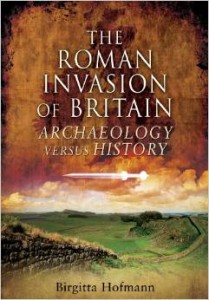The Roman Invasion of Britain. Archaeology versus History, Birgitta Hoffmann
Pen & Sword Archaeology (imprint of Pen & Sword Books), Barnsley 2013
ISBN: 978-1-84884-097-3
Hardcover with dust jacket, illustrations and maps in black and white, appendices, bibliography and index
222 pages
£19,99 / €25,99
The Roman conquest of Britain unravelled
In The Roman Invasion of Britain archaeologist Birgitta Hoffmann, specialized in the Roman frontier area in northern Britain, puts together all the literary and material evidence that is available to us to construct the narrative of the Roman advance in England, Wales and Scotland. By comparing archaeological records and written sources she wants to separate known facts and speculations about the Roman presence, since a lot of speculations have become accepted facts over time. The book starts with an introduction in which Hoffmann considers the usefulness of ancient sources and the intentions ancient historians had when writing them. They constructed moral and social histories rather than strict objective accounts of the historical events they were describing. Therefore the use of archaeology is indispensable in creating a picture of the past as valid as possible. The author then goes forth stressing the importance of using both archaeology and history to create the most valid image of the past that can be reached.
Hoffmann starts her examination with the first Roman incursion in Britain under Caesar in 55 BC, and her unravelling of Caesar’s hidden motives and aims in writing his ‘Gallic War’ will not appear unfamiliar to those studying these campaigns. Hoffmann proceeds with an investigation of the Celt Commius, who in Roman sources appears both as a Gallic leader and as a British king. The question is if these were related or even one and the same person. As happens so often in these specific cases, the evidence is too scanty to make anything more than an educated guess. However, it looks like the easiest explanation is also the most probable; there just were two Commiuses. In the history of Roman Britain, it is a recurrent difficulty that neither archaeology nor ancient sources can give us definite answers on our questions. In those frequent cases, it is refreshing that Hoffmann doesn’t lose herself in farfetched speculations but simply admits we don’t know enough to say anything sensible about them.
After the first Roman steps on the island with Caesar, the author continues with the Claudian invasion and the discussion of the numerous possible landing sites of the Roman army, with Fishbourne and Richborough receiving much attention because of their old ‘prominence’ as possible landing places. Again evidence is lacking to produce a truly convincing picture. Next is the treatment of the Welsh conquest and the campaigns against Caratacus. Very interesting is the section on the Roman forts found in the area, and, those not (yet) found. Further on Hoffmann analyses the Boudiccan revolt of 60-61 AD in the available sources; Suetonius, Tacitus and Cassius Dio. The origins, course and aftermath of the rebellion are dealt with. As the author concludes, major defeats in battle didn’t stop tribes from fighting, as can be seen in Gaul prior to the siege of Alesia. Although Tacitus wants to believe it did, Cassius Dio claims the contrary. Therefore it seems that Tacitus mainly uses this ‘decisive battle’ to round up his narrative of Boudicca and Caratacus in a literary nice way. Interesting to point out in this case is that the same stubbornness was true for Republican Rome. After heavy defeats they just raised another army to continue the fight, and when that would be destroyed, they raised another. One only has to take a look at the Second Punic War and the battles against Hannibal as an example.
At this point in the book Hoffmann reaches familiar ground, as she proceeds to investigate Rome’s northern frontier area in Britain. She examines the extent to which the Roman army used the natural features of the Highlands as a true frontier already at the end of the first century, instead of using it as a springboard for further incursions into the north of Scotland as is usually thought. It seems that even as early as the end of the first century there were Roman tendencies to consolidate the territory gained, just like the consolidation that started with the building of Hadrian’s Wall from the second century onwards. Especially interesting are the parts on Hadrian’s Wall and the Antonine Wall. Hoffmann, herself an experience excavator at Hadrian’s Wall, examines the building and use of both defensive structures by the Romans and explores the reasons for building and causes for abandoning them. The building of both Walls was a massive undertaking that continued in phases of more and less activity. Also, there can be seen no linear Roman advance and gradual retreat afterwards at the northern frontier. These also came with ebbs and flows.
All in all Hoffmann’s account is everything it claims to be; a thorough up-to-date synthesis of the actual available evidence on the Roman conquest of Britain, without making too much speculations on what might have happened or maybe was. It sets off all available evidence from historical sources against the archaeological finds and distils from it an acceptable image of the Roman conquest that can withstand critical scrutiny. While also taking into account all recent literature on the subject the author sketches with it a much-nuanced picture of what we exactly know of Roman Britain, and maybe even more important, what we don’t exactly know. For those who by reading the book are triggered to find out more about the subject, Hoffmann’s account contains a wealth of reference material for further study. Therefore those interested in Roman Britain cannot afford it to ignore this book.
Wouter van Dijk


Pingback:
Edge of Empire, Jona Lendering & Arjen Bosman |